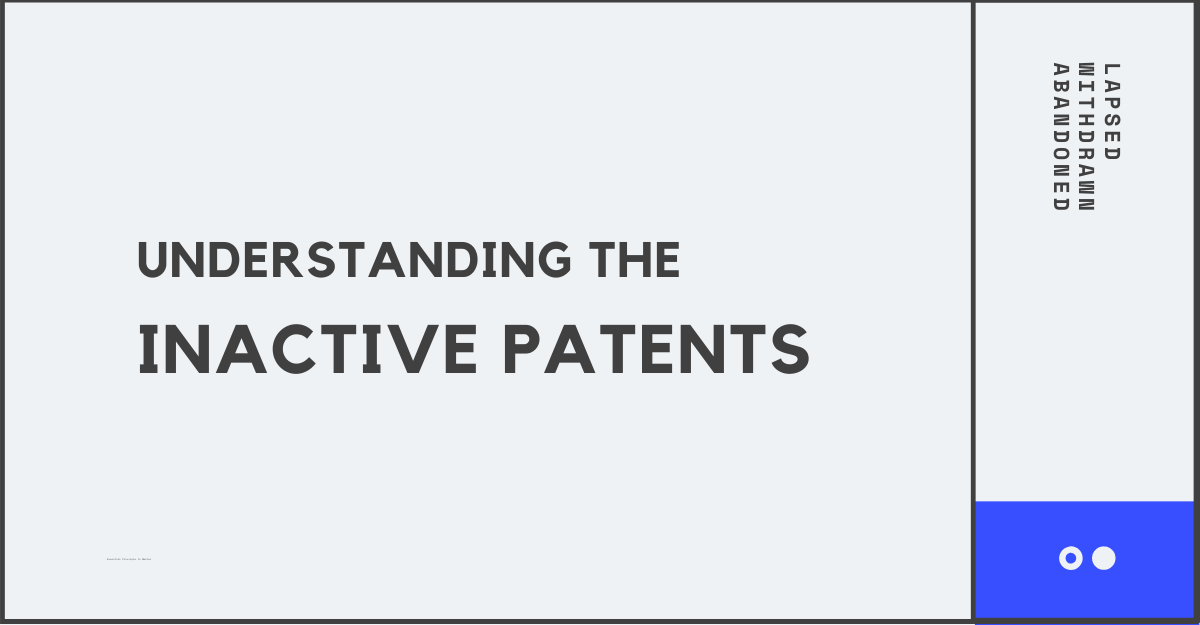A patent is usually granted for a period of 20 years. In the contemporary, technology-oriented world, 20 years is a long time to wait. It is essential to understand that not all patents see the entire term of 20 years through. A lot of patents are rendered inactive much before their natural lifetime ends. Inactive patents enter the public domain and become free-to-use for anyone. Inactive patents are, therefore, a goldmine for inventors and innovators. Using inactive patents will not constitute patent infringement.
What are inactive patents?
The inactive patents are lapsed, abandoned, or withdrawn patents. In simple terms, patents that are no longer active are called inactive patents. The inactive patents cannot be enforced or monetized anymore. This means that the owner of the patent is no longer entitled to exclusive use of the patent. The patent enters the public domain, and anyone can use it.
When does a patent become inactive?
A patent can be rendered inactive under various circumstances. Before a patent is granted, the patent application may become inactive if: the applicant abandons the patent application, if the applicant withdraws the patent application. After a patent is granted, the patent may become inactive if: the patent renewal fee is not paid, the patent has expired (a patent has finished its 20-year term), or if the patent is revoked.
In this article, we are going to delve into patents that have become inactive because of the non-payment of renewal fees as well as patents that have been revoked.
| Patent Status | Explanation | Reason |
| Inactive | Lapsed | Non-payment of maintenance/ renewal fee |
| Inactive | Expired | A patent has finished its 20-year term |
| Inactive | Revoked | A patent was revoked upon application by a third party. |
What are Lapsed Patents?
Patents will lapse if the annual renewal/ maintenance fee is not paid. According to Section 53(2) of the Indian Patent Act, 1970, a patent will cease to have effect if the renewal fee is not paid.
An annual renewal fee has to be paid before the expiration of the second year from the date of the patent, in respect of the third year. After that, the renewal fee has to be paid every succeeding year. The fee has to be paid before the due date. If it is not paid within the due date, then an application can be made requesting for an extension of time. The time extension given is six months, so the renewal fee has to be paid within six months after the due date.
Can Lapsed Patents be Restored?
Yes. Lapsed patents can be restored. According to Section 60 of the Indian Patent Act, 1970, lapsed patents can be restored within 18 months from the date of lapse. Rule 138 states that there can be a one-month extension to the 18 months, upon the discretion of the Controller.
The application for the restoration of the lapsed patent must contain a detailed explanation about the circumstances that led to the non-payment of the renewal fee. Evidence must be submitted to show that the delay was unintentional. The applicant must further show that there was no undue delay in filing the restoration application.
After examining the application and the supporting evidence, if the Examiner is convinced, then the patent will be restored and published in the Official Gazette.
How to retrieve Lapsed Patents?
There is an Indian database to retrieve lapsed patents. On the website, select the tab ‘Ceased Due to Non Renewal.’ In the ‘Field of Invention,’ choose the field of the invention that you want to search. This database lists out all inventions, the renewal of which has been discontinued.
What is Revoked Patents?
Once a patent has been granted, a third-party may cause the patent to be revoked by filing an application for the same. If the application has merit and the patent is revoked, it becomes inactive.
Who can file for Revocation of the Patent?
According to Section 64 of the Indian Patent Act, 1970, a revocation application may be filed by:
– Any interested person;
– The Central Government;
– As a counter-claim in a suit for infringement of the patent
What are the Grounds for Filing for Revocation?
Section 64 lists out various grounds for filing for revocation of a patent:
* The invention claimed in the patent specification is already claimed in another patent granted in India, with an earlier priority date or filing date.
* The patent was granted to a person who was not rightfully entitled to the patent.
* The person to whom the patent is granted obtained the patent wrongfully from a third party. In such a situation, the third party has the right to file for revocation.
* Any claim in the specification is not an invention within the meaning of the Patent Act.
* The invention is not new and was already public knowledge before the patent application was filed.
* The invention is obvious and does not contain an inventive step.
* The invention is not useful.
* The invention is not described sufficiently enough, so as to enable a person of average intelligence in the field which the patent pertains to, to reproduce the invention. Or, the best method of producing the invention, as known to the patent owner, is not revealed.
* The scope of the claim is not clearly described or that the claim is not based on the matter disclosed in the specification.
* Patent was obtained on a false suggestion or representation.
* The subject of any claim is not patentable according to the Indian patent Act.
* The invention was secretly used in India before the priority date claim.
* The patent owner furnished false information.
* The patent owner contravened any direction for secrecy.
* The leave to amend the complete specification was obtained by fraud.
* The complete specification does not disclose or wrongly mentions the geographical origin of any biological material used in the invention.
* The invention was anticipated, given the knowledge, oral or otherwise, available within any local or indigenous community.
Further, under Section 65, if a patent relates to atomic energy, it can be revoked.
According to Section 66, a patent can be revoked in the public interest, if the Central Government is of the opinion that a patent or the mode in which it is exercised was mischievous to the State or prejudicial to the public, it may revoke the patent, after giving the patent holder a chance to be heard.
Therefore, while a patent is usually granted for 20 years, not every patent sees the entire term through. Most patents are rendered inactive, for the reasons listed above, before the completion of the 20-year term.




